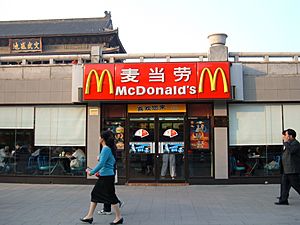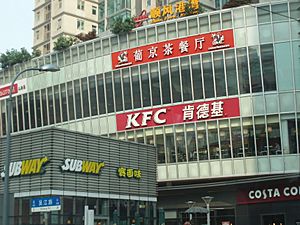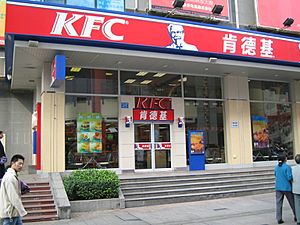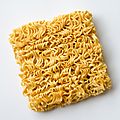Fast food in China facts for kids
Western-style fast food in mainland China is a fairly new thing. Kentucky Fried Chicken (KFC) opened its first restaurant in Beijing in November 1987. It was super popular and became a role model for many Chinese restaurants that opened later.
Contents
The Story of Fast Food in China
The first fast food restaurant in China was "Yili's Fast Food Shop" in Beijing, back in 1906. That's a long time ago!
Over the years, China's economy grew very fast. This led to many changes in how people live and eat. More people started trying Western-style food. This change in diet might be linked to more people becoming overweight.
Pizza Hut and McDonald's opened in China in 1990. KFC had already opened three years before them. At first, the McDonald's in Shenzhen got its supplies from Hong Kong. But by 1992, when the first McDonald's opened in Beijing, mainland China had its own good supply system.
By 2013, there were about 4,200 KFC restaurants in over 850 Chinese cities. Pizza Hut had more than 1,300 restaurants in China.
Popular Fast Food Chains
Kentucky Fried Chicken (KFC)
KFC's Start in Beijing
KFC, also known as 肯德基, became incredibly successful in China. Its first Beijing restaurant opened in November 1987. With 500 seats, it was the biggest fast food restaurant in the world at the time! In 1988, it cooked 2,200 chickens every day. It earned more money than any other KFC in the world. By 1994, KFC had 28 restaurants across China, with seven in Beijing.
Why Kids Love KFC
KFC quickly learned that kids really liked their restaurants. Chinese parents often let their children pick where to eat. So, KFC worked hard to make kids even happier.
One big change was the KFC logo. In 1995, the old man in the logo was replaced with a fun cartoon chicken called "Chicky." KFC also added play areas, smaller sinks, and furniture for kids. They even started hosting birthday parties, which were new in China. All these things made KFC a fun and exciting place for kids to eat.
KFC vs. Local Restaurants
A KFC in Beijing is right across from a Chinese fried-chicken restaurant. The Chinese place had cheaper prices and bigger portions. It also offered rice, soup, vegetables, and beer. But KFC almost always had more customers. Why? Because of how clean it was!
KFC employees in China constantly clean the restaurant and bathrooms. This made KFC much cleaner than most local Chinese restaurants. People in China really liked how clean KFC was. They even started wishing other restaurants were as tidy.
KFC's Big Success
KFC's success in China comes from how customers feel about its brand. Chinese customers generally eat at KFC more often than American customers. They also have a more positive view of it. Chinese people like KFC's clean space and early opening hours. Americans like it because it's affordable and a full meal.
KFC also created a special menu just for China. You can find different kinds of rice porridge, fried dough sticks, and soy milk for breakfast. This "localization" strategy helped KFC a lot. Even when there was a problem with a harmful dye in some chicken in 2005, KFC still grew. They opened hundreds of new stores and made more money that year. This shows how well they understood the Chinese market.
KFC's Green Efforts
Like other fast food companies, KFC is trying to be more eco-friendly. They plan to stop using plastic products. Instead, they will use wooden forks and spoons. They will also use packaging that breaks down naturally. Plastic bags will be replaced with paper bags for delivery and takeout. This follows a plan set by Beijing in 2019 to reduce plastic waste.
McDonald's

McDonald's Arrives in China
The first McDonald's in mainland China opened in 1990 in Shenzhen. The biggest McDonald's in the world opened in Beijing on April 23, 1992. It had 700 seats and 29 cash registers. On its opening day, it served over 40,000 people! By 1996, 29 McDonald's had opened in Beijing alone.
At first, mostly rich families ate there. It was a way to show off and try new foreign things. McDonald's became a symbol of a new lifestyle. One big reason for McDonald's success in China is its high standards for cleanliness. Beijing news often praised McDonald's for being clean. They compared it to other places that were not as tidy.
KFC vs. McDonald's in China

KFC came to China in 1987, and McDonald's followed three years later. By 2018, KFC had 5910 restaurants in China. McDonald's had 2700. KFC opened new stores faster than McDonald's. But both chains liked to open in big cities.
They have always competed, which is a good thing! Their rivalry helps more Chinese customers try Western fast food. It also makes the whole fast food market bigger. McDonald's often opens new places near successful KFC locations. KFC benefits from McDonald's by making more people interested in Western fast food.
McDonald's and Kids
McDonald's also appeals strongly to children. Many McDonald's had "children's paradise" areas where kids could run and play. Parents in Hong Kong would take their kids to McDonald's as a reward for good behavior or good grades. Because of this, McDonald's became a special childhood memory for many.
The Big Mac in China
In the 1990s, McDonald's showed off an American image and the idea of being modern. McDonald's was very strict about food quality, which made customers trust its cleanliness. People also liked that prices were the same for everyone. This made them feel equal.
McDonald's meals, like a burger and fries, were seen as a snack. Traditional Chinese meals usually have rice, vegetables, or meat dishes. McDonald's and other foreign fast foods were a special treat. Some families would save money for days just to eat there. This made McDonald's feel like a cultural experience, not just a regular meal.
McDonald's Green Actions
Beijing Simplot Food Processing, a main supplier of fries to McDonald's in China, was fined for polluting water. McDonald's said they would watch their suppliers closely. They stated that all suppliers must follow local laws.
McDonald's has also changed its packaging to be more eco-friendly. They plan to open 1,800 "green" restaurants between 2018 and 2022. They follow special building standards to reduce waste. Their packaging goals are to use materials responsibly, reduce waste, and make things better.
Burger King
Burger King in Shanghai
Burger King, known as 汉堡王 (Hànbǎowáng), opened its first restaurant in Shanghai on June 27, 2005. They offered their famous Whopper. They also had special items for Chinese tastes, like the Spicy Mala Burger. As of 2012, a company called TFI runs over 1,200 Burger Kings in China. This makes them the biggest Burger King owner in the world!
Burger King's Challenges and Success
Burger King arrived when KFC and McDonald's were already big rivals in China. Burger King faced a challenge because many Chinese people prefer chicken over beef. Since the Whopper is a beef burger, Burger King had to change. They found success by attracting younger people who liked new things. These customers mostly lived in big cities.
Starbucks
Starbucks in Beijing
Starbucks is famous for coffee, drinks, and quick food. Its first store in China opened in Beijing in January 1999. By 2021, Starbucks had opened 5,000 stores in 200 cities across mainland China.
Starbucks' Green Efforts
Starbucks has a "GOOD GOOD" movement. It's about changing from plastic straws to more sustainable options. They use biodegradable straws made from coffee grounds. Wooden cutlery is replacing plastic. They also offer reusable cups for in-store use. Starbucks aims to cut carbon, water, and waste by 50% globally by 2030.
Starbucks' Competition
China is Starbucks' fastest-growing market outside the U.S. But new local coffee shops are growing fast. Other foreign brands like illy Caffè and Tim Hortons are also trying to gain customers. In 2021, the tea drink market in China was twice as big as the coffee market. There are four times more milk tea and juice stores than coffee shops.
Chinese vs. American Fast Food
Chinese fast food companies haven't been as successful as American ones. One reason is that Chinese food is already often fast and easy to get. But American food feels more exciting and new.
The second big reason is cleanliness. McDonald's and KFC in China put a huge focus on being clean. Customers often chose them over Chinese fast food places because of this.
Coupons also helped American fast food. Even if prices were similar, coupons made the food seem cheaper. This helped more people try the food and remember the brands. By giving out coupons, McDonald's and KFC became well-known in Chinese cities.
KFC added Chinese food to its menu. They offered dishes like congee (rice porridge), egg tarts, and breakfast rice rolls. This made KFC's menu similar to Chinese restaurants but with an American twist. This helped attract many local customers. KFC also expanded very quickly. They opened many restaurants in major cities. This helped them become big before Chinese fast food chains could grow as much.
Fast food companies in China have changed a lot to fit the market. Flavors and menus are different from those in the U.S. They also have new ways of advertising to Chinese customers.
Pizza Hut also changed its image in China. In the U.S., Pizza Hut is a low-priced pizza place. But in China, it became a mid-priced restaurant. Pizza Hut in China added wine lists and fancy three-course meals. This made it feel more classic. They also added Chinese ingredients to their food. For example, you can find Beijing duck pizza, Szechuan lobster spaghetti, and bubble tea.
Drive-throughs were new in China in the early 2000s. Cars themselves were still quite new for many people. Many didn't know how to use a drive-through! By 2008, there were only 26 drive-throughs in China. They have become more known over time but are not as popular as in other countries.
How Fast Food Spread in China
Phase 1: Starting Points (1994–2000)
When McDonald's and KFC first came to China, they seemed like fancy Western places. They opened their first restaurants in nice shopping centers, office areas, and near universities.
Phase 2: Shopping and Travel Spots (2001–2005)
Later, McDonald's and KFC opened in more shopping areas and transportation hubs. They started to appeal to young, trendy people. Fast food began to feel less foreign to Chinese locals.
Phase 3: Everyday Places (2006–2012)
In the final phase, McDonald's and KFC stopped focusing only on big city hot spots. They started opening in residential areas. They also added more Chinese flavors to their food. They used less American symbols in their restaurants. This made them feel even more like local places. Eating at American fast food restaurants became a normal thing for Chinese families, not just for special occasions.
Instant Noodles and Food Delivery
Chinese people used to eat a lot of instant noodles to save time. But now, more fast food restaurants are opening. Also, food delivery apps are a big threat to instant noodles. These apps let people order food right to their door. This is a main reason why instant noodle sales have gone down.
About 730 million people in China use the internet, and most of them have smartphones. These apps offer many food choices. They are replacing instant noodles for many Chinese customers.
Food Delivery in China
Super Convenient Food
Food delivery became popular because it's so easy. Many fast food restaurants now deliver their own food. This demand grew because American delivery companies came to China in 2010. By 2020, the Chinese food delivery market was twice as big as the U.S. market!
Many Chinese workers have very busy schedules, sometimes working from 9 AM to 9 PM, six days a week. Food delivery helps them fit meals into their busy lives. Delivery apps also offer coupons and special deals. This helps busy people save money when they order food.
Environmental Worries
The rise of food delivery causes a lot of waste. Every delivery comes with disposable containers and single-use chopsticks. This has led to concerns about the environment. The more food delivery orders there are, especially for short distances, the more waste and pollution.
In China, most delivery items use plastics that are not easy to recycle. In the U.S., many delivery orders come in paper or cardboard, which are more eco-friendly.
Greener Choices
Companies are looking for ways to make delivery more sustainable. They want to use greener packaging. One idea is for people to walk to nearby restaurants instead of ordering delivery for short distances. This helps them get exercise and reduces vehicle use and packaging waste.
Companies are also thinking about using electric motorcycles for deliveries instead of gas-powered ones. These electric bikes can travel far on one charge. This gives delivery companies cleaner ways to bring food to customers.
Images for kids





